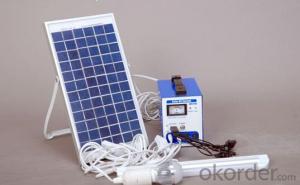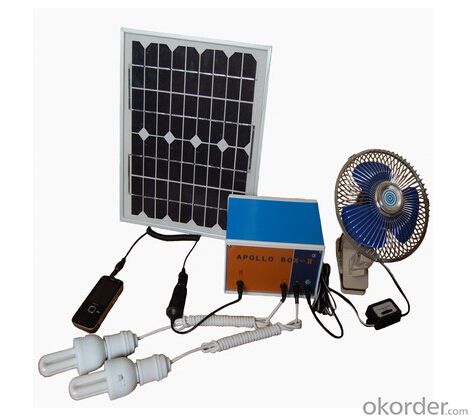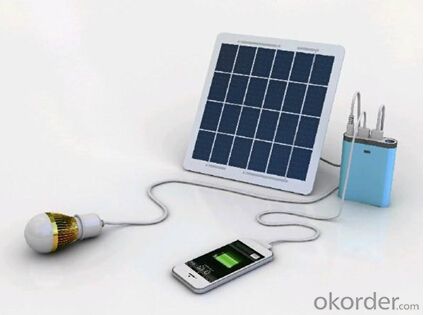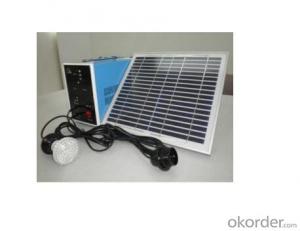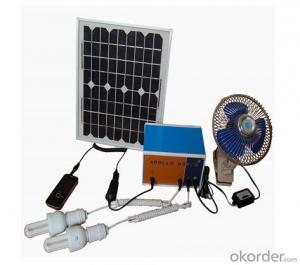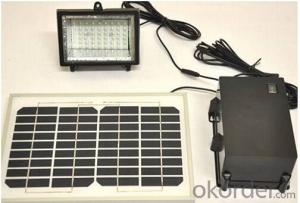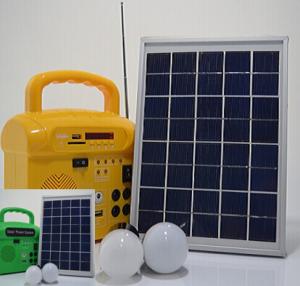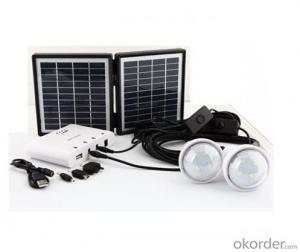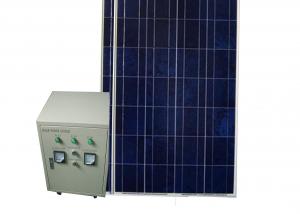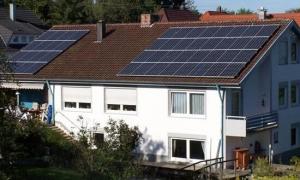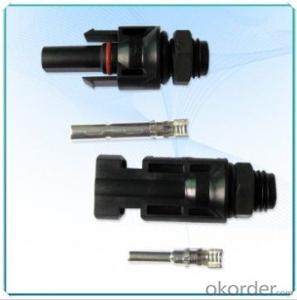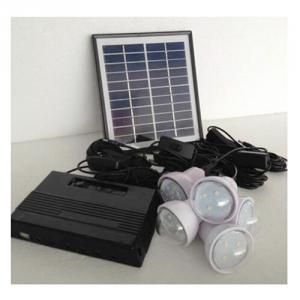American Solar Energy Systems CNBM Solar Home System Roof System Capacity-20w-3
- Loading Port:
- Shanghai
- Payment Terms:
- TT or LC
- Min Order Qty:
- 10 m
- Supply Capability:
- 30000 m/month
OKorder Service Pledge
OKorder Financial Service
You Might Also Like
Introduction of Solar Home System
Solar Home System is composed by Solar Panels, Inverters, Charger Controller, Battery, Cable, Mounting Bracket, which is applied to produce electricity for home use.
Solar Home System is quite suitable product in urban area and the place which is short of electricity. Our Small Solar Home System own great benifits compare with other kind electricity resources:
Electricity generating cost of Solar Home System is much cheaper than diesel engine. Beside low electricity making cost, solar system products also have the features of noiseless, clean energy, environmentally friendly and can access to many different electric appliance.
Working Principle of Solar Home System
The stand alone Solar Home System is an off-grid solar system which uses batteries to store the solar energy. Stand alone solar system solutions design for those who are not able or willing to connect to electricity grid.
However, our on-grid solar home system can be connected to the grid for utilization of grid electricity power. Our solar system can add relative equipment as our customer’s requirement which have the function of switching to city electricity automatically. The solar system can use battery power in priority, if sunshine is not so good or loads consumption is too high which cause battery power insufficient. Then system can switch automatically to grid power supply. Meanwhile, the system can charge the batteries with grid power until batteries are fully charged. Then the solar system will switch back to battery power supply.
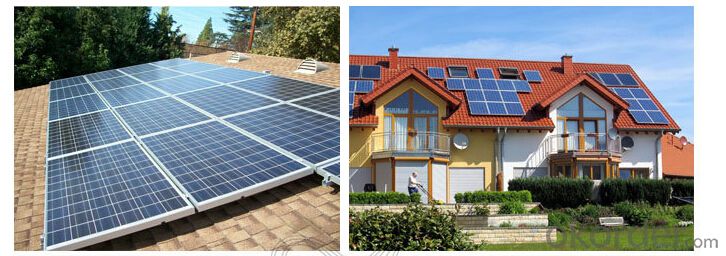


Advantage of Our Solar Home System
1 Excellent Performance: Our Solar Home System is composed by Brand Standard Kits with high quality. Our solar system has the advantage of high efficiency and stable operation. We can ensure our product with a long life period.
2. Small Orders Accepted: We can accept small orders as our customer’s trial order.
3. Warehouse: We have warehouse overseas which can bring great convenience to our customer to pick up the products.
Terms and Conditions
1. Trade terms: FOB Shanghai
2. Payment terms: 30% T/T, balanced before shipment/ LC at sight before shipment. Actual Terms can be negotiated for big order.
3. Package: Exported standard package suitable for tough handling and sea transport.
4. Delivery: Goods to be ready within 10~30 days depending on order quantity.
5. Warranty: 10 years for solar panel, 2 years for controller/inverter/battery.
- Q: Can solar energy systems be used for commercial buildings?
- Yes, solar energy systems can be used for commercial buildings. In fact, many businesses are adopting solar power as a sustainable and cost-effective energy solution. Solar panels can be installed on rooftops or as ground-mounted systems to generate electricity, reducing reliance on traditional energy sources and lowering utility bills. Additionally, commercial buildings often have large surface areas suitable for solar panel installation, making them ideal candidates for harnessing solar energy.
- Q: How do solar energy systems impact regional economic development?
- Solar energy systems have a positive impact on regional economic development. They create new job opportunities in the installation, maintenance, and manufacturing sectors. These systems also attract private investment, stimulate local businesses, and reduce electricity costs for industries and households. Additionally, solar energy systems contribute to a cleaner environment, which can attract tourism and enhance the overall image of the region.
- Q: Can solar energy systems be used for powering mining or drilling operations?
- Yes, solar energy systems can be used to power mining or drilling operations. Solar panels can generate electricity in remote locations where it may be challenging or expensive to bring in traditional power sources. This renewable energy source can help reduce the environmental impact of mining and drilling operations by reducing reliance on fossil fuels. Additionally, solar energy systems can provide a reliable and sustainable power supply for these energy-intensive operations.
- Q: What is the impact of roof pitch on the performance of solar panels?
- The performance of solar panels is significantly impacted by the roof pitch, which refers to the angle at which the roof is sloped. Various factors, such as geographical location and desired energy output, determine the ideal roof pitch for solar panels. One of the main effects of roof pitch on solar panel performance is the amount of sunlight the panels receive. The angle of the roof determines how directly sunlight hits the panels. Generally, a steeper roof pitch allows for better solar panel performance as it maximizes sun exposure throughout the day. This is particularly important in areas with lower solar irradiance or during seasons with shorter daylight hours. Another important factor to consider is the self-cleaning effect of roof pitch. A steeper roof angle helps rainwater naturally clean the solar panels, reducing the accumulation of dust, dirt, and debris. This helps maintain panel efficiency over time, as a cleaner surface enables better light absorption. Moreover, the roof pitch impacts the efficiency of snow shedding. In regions with heavy snowfall, a steeper roof pitch allows snow to slide off more easily, preventing snow accumulation on the panels and ensuring their functionality during winter months. However, it's important to note that the impact of roof pitch on solar panel performance is not linear. While a steeper roof pitch can offer advantages, there is an optimal angle that maximizes energy production based on the specific latitude of the installation site. This is typically calculated by considering factors such as the sun's angle of incidence and the time of year. In conclusion, the roof pitch plays a crucial role in the performance of solar panels by affecting sunlight exposure, facilitating self-cleaning, and aiding snow shedding. Choosing the appropriate roof pitch based on geographical location and energy goals is essential to optimize the efficiency and effectiveness of solar panel installations.
- Q: What is the role of solar energy systems in reducing water usage?
- Solar energy systems can play a significant role in reducing water usage by using sunlight to produce electricity instead of relying on traditional power plants that require large amounts of water for cooling purposes. This helps conserve water resources and mitigates the impact on aquatic ecosystems. Additionally, solar-powered irrigation systems can be used in agriculture, reducing the reliance on water-intensive irrigation methods, further contributing to water conservation efforts.
- Q: What is the impact of roof orientation on the performance of solar panels?
- The impact of roof orientation on the performance of solar panels is significant. The orientation of the roof determines the amount of sunlight that the panels receive throughout the day. Ideally, solar panels should be installed on roofs that face south in the northern hemisphere and north in the southern hemisphere for maximum exposure to sunlight. East and west-facing roofs can still generate electricity, but their output may be lower. Additionally, the tilt angle of the roof can also affect the performance of solar panels. By optimizing roof orientation and tilt, the efficiency and productivity of solar panels can be greatly enhanced.
- Q: Can solar energy systems be used in extreme weather conditions?
- Yes, solar energy systems can be used in extreme weather conditions. While extreme weather conditions may affect the efficiency of solar panels, they are designed to withstand harsh conditions such as high temperatures, strong winds, and heavy snowfall. Additionally, advancements in technology and engineering have improved the resilience and durability of solar energy systems, making them suitable for use in various weather conditions.
- Q: Can solar panels be integrated into building materials like windows or roofing tiles?
- Yes, solar panels can be integrated into building materials like windows or roofing tiles. These types of solar panels are known as building-integrated photovoltaics (BIPV). BIPV technology allows for the seamless integration of solar panels into various building materials, providing both energy generation and architectural functionality. This integration helps maximize space utilization and promotes sustainable energy generation within the built environment.
- Q: How do solar energy systems impact the electric grid?
- Solar energy systems have a significant impact on the electric grid by reducing the demand for electricity from traditional sources. As more solar power is generated and fed into the grid, it helps to stabilize the grid by diversifying the energy mix. Additionally, solar systems can reduce peak demand during daylight hours, leading to cost savings and less strain on the grid infrastructure. However, the intermittent nature of solar power can pose challenges in grid management, requiring grid operators to carefully balance supply and demand to ensure grid reliability.
- Q: Are there any limitations to the amount of electricity a solar energy system can generate?
- Yes, there are limitations to the amount of electricity a solar energy system can generate. These limitations include factors such as the size and efficiency of the system, the amount of sunlight available, and the geographical location of the system. Additionally, external factors like weather conditions and shading can affect the system's performance and limit its electricity generation.
Send your message to us
American Solar Energy Systems CNBM Solar Home System Roof System Capacity-20w-3
- Loading Port:
- Shanghai
- Payment Terms:
- TT or LC
- Min Order Qty:
- 10 m
- Supply Capability:
- 30000 m/month
OKorder Service Pledge
OKorder Financial Service
Similar products
Hot products
Hot Searches
Related keywords
